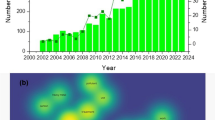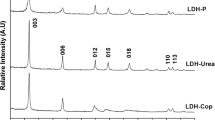Abstract
Highly efficient porous adsorbent has been developed by simple and inexpensive surface modification of mesoporous SBA-15 via an alternate adsorption of cationic poly(diallyldimethylammonium ion) and anionic poly(diallylaspartate). The nature of the charge on the surface after modification was confirmed by Zeta potential measurement. The surface morphology, topography, and its textural properties were examined by atomic force microscopy (AFM) and Nitrogen adsorption/desorption, respectively. TGA has been performed to ascertain the amount of polymer layer on the silica material. Multi-parameter isotherm models were used for the analyses of experimental data. The new protocol is found to be very impressive in the removal of toxic Cd(II) pollutant with an experimental maximum uptake capacity of 160 mg g–1.

Bilayered polyelectrolyte-coated silica for remediation of wastewater with enhanced removal of Cd ions.
Highlights
-
An aspartic acid-based polymer was immobilized on mesoporous silica SBA-15.
-
Modification of the silica surface was achieved via simple layer-by-layer deposition.
-
The biogenic amino acid residues imparted remarkable efficacy to remove Cd(II).









Similar content being viewed by others
References
Järup L, Åkesson A (2009) Current status of cadmium as an environmental health problem. Toxicol Appl Pharmacol 238:201–208.
Peters JL, Perlstein TS, Perry MJ, McNeely E, Weuve J (2010) Cadmium exposure in association with history of stroke and heart failure. Environ Res 110:199–206.
Biswas B, Sarkar B, Mandal A, Naidu R (2016) Specific adsorption of cadmium on surface-engineered biocompatible organoclay under metal-phenanthrene mixed-contamination. Water Res 104:119–127.
Chen YY, Yu SH, Jiang HF, Yao QZ, Fu SQ, Zhou GT (2018) Performance and mechanism of simultaneous removal of Cd(II) and Congo red from aqueous solution by hierarchical vaterite spherulites. Appl Surf Sci 444:224–234.
Novacek M, Jankovsky O, Luxa J, Sedmidubsky D, Pumera M, Fila V et al. (2017) Tuning of graphene oxide composition by multiple oxidations for carbon dioxide storage and capture of toxic metals J Mater Chem A 5:2739–2748.
Hossein Beyki M, Ghasemi MH, Jamali A, Shemirani F (2017) A novel polylysine–resorcinol base γ-alumina nanotube hybrid material for effective adsorption/preconcentration of cadmium from various matrices. J Ind Eng Chem 46:165–174.
Das SK, Wang X, Ostwal MM, Lai Z (2016) A highly stable microporous covalent imine network adsorbent for natural gas upgrading and flue gas CO2 capture. Sep Purif Technol 170:68–77.
Marczewski AW, Derylo-Marczewska A, Skrzypek I, Pikus S, Kozak M (2009) Study of structure properties of organized silica sorbents synthesized on polymeric templates. Adsorption 15:300–305.
Beck JS, Vartuli JC, Roth WJ, Leonowicz ME, Kresge CT, Schmitt KD et al. (1992) A new family of mesoporous molecular sieves prepared with liquid crystal templates J Am Chem Soc 114:10834–10843.
Feng X, Fryxell GE, Wang L-Q, Kim AY, Liu J, Kemner KM (1997) Functionalized Monolayers on Ordered Mesoporous Supports. Science (80) 276:923–926.
Walcarius A, Mercier L (2010) Mesoporous organosilica adsorbents: nanoengineered materials for removal of organic and inorganic pollutants. J Mater Chem 20:4478–4511.
Yantasee W, Rutledge RD, Chouyyok W, Sukwarotwat V, Orr G, Warner CL et al. (2010) Functionalized nanoporous silica for the removal of heavy metals from biological systems: adsorption and application ACS Appl Mater Interfaces 2:2749–2758.
Netzer LSJ (1983) ω-Hexadecenyltrichlorosilane has proven to be a useful, modifiable, siloxy-anchored amphiphile. J Am Chem Soc 105:674–676.
Mihai M, Schwarz S, Janke A, Ghiorghiţǎ CA, Drǎgan ES (2013) Silica microparticles surface coating by layer-by-layer or polyelectrolyte complex adsorption. J Polym Res 20: 89. https://doi.org/10.1007/s10965-013-0089-5.
Dragan ES, Schwarz S, Eichhorn K-J (2010) Specific effects of the counterion type and concentration on the construction and morphology of polycation/azo dye multilayers. Colloids Surf A 372:210–216.
Yasmin T, Müller K (2011) Synthesis and characterization of surface modified SBA-15 silica materials and their application in chromatography. J Chromatogr A 1218:6464–6475.
Jamiu ZA, Al-Muallem HA, Ali SA (2015) Aspartic acid in a new role: Synthesis and application of a pH-responsive cyclopolymer containing residues of the amino acid. React Funct Polym 93:120–129.
Zhao D, Huo Q, Feng J, Chmelka BF, Stucky GD (1998) Nonionic triblock and star diblock copolymer and oligomeric surfactant syntheses of highly ordered, hydrothermally stable, mesoporous silica structures. J Am Chem Soc 120:6024–6036.
Zhao D, Feng J, Huo Q, Melosh N, Fredrickson GH, Chmelka BF et al. (1998) Triblock copolymer syntheses of mesoporous silica with periodic 50 to 300 Angstrom pores Science (80) 279:548–552
HP B (1966) Chemical identification of surface groups. In: Eley, DD, Pines Herman WPB (eds) Advances in catalysis. Academic Press Inc., New York, pp. 179–274.
Salis A, Parsons DF, Boström M, Medda L, Barse B, Ninham BW et al. (2010) Ion specific surface charge density of SBA-15 mesoporous silica Langmuir 26:2484–2490.
Boehm HP (1994) Some aspects of the surface-chemistry of carbonblacks and other. Carbons Carbon N Y 32:759–69.
Leonardelli S, Facchini L, Fretigny C, Tougne P, Legrand AP (1992) Silicon-29 NMR study of silica. J Am Chem Soc 114:6412–6418.
Sindorf DW, Maciel GE (1981) Silicon-29 CP/MAS NMR studies of methylchlorosilane reactions on silica gel. J Am Chem Soc 103:4263–4265.
Maciel GE, Sindorf DW (1980) Silicon-29 NMR study of the surface of silica gel by cross polarization and magic-angle spinning. J Am Chem Soc 102:7606–7607.
Sindorf DW, Maciel GE (1983) Silicon-29 NMR study of dehydrated/rehydrated silica gel using cross polarization and magic-angle spinning. J Am Chem Soc 105:1487–1493.
Legrand AP, Hommel H, Taïbi H, Miquel JL, Tougne P (1990) Contribution of solid state NMR spectroscopy to the characterization of materials. Colloids Surf 45:391–411.
Grünberg A, Yeping X, Breitzke H, Buntkowsky G (2010) Solid-state NMR characterization of Wilkinson’s catalyst immobilized in mesoporous SBA-3 silica. Chemistry 16:6993–8.
Groen JC, Peffer LA, Pérez-Ramı́rez J (2003) Pore size determination in modified micro- and mesoporous materials. Pitfalls and limitations in gas adsorption data analysis. Microporous Mesoporous Mater 60:1–17.
Jaroniec C, Gilpin R, Jaroniec M (1997) Adsorption and thermogravimetric studies of silica-based amide bonded phases. J Phys 44242:6861–6866.
Iler RK (1979) The chemistry of silica: solubility, polymerization, colloid and surface properties and biochemistry. John Wiley, New York.
Erto A, Di Natale F, Musmarra D, Lancia A (2015) Modeling of single and competitive adsorption of cadmium and zinc onto activated carbon. Adsorption 21:611–621.
Huang J, Yuan F, Zeng G, Li X, Gu Y, Shi L et al. (2017) Influence of pH on heavy metal speciation and removal from wastewater using micellar-enhanced ultrafiltration Chemosphere 173:199–206.
Abbas M, Kaddour S, Trari M (2014) Kinetic and equilibrium studies of cobalt adsorption on apricot stone activated carbon. J Ind Eng Chem 20:745–751.
Morris WJW, JC (1963) Intraparticle diffusion during the sorption of surfactants onto activated carbon. Eng Div Am Soc Civ Eng 89:31–60.
Kavitha D, Namasivayam C (2007) Experimental and kinetic studies on methylene blue adsorption by coir pith carbon. Bioresour Technol 98:14–21.
Wu F-C, Tseng R-L, Juang R-S (2009) Initial behavior of intraparticle diffusion model used in the description of adsorption kinetics. Chem Eng J 153:1–8.
Ho YS, Porter JF, Mckay G (2002) Divalent metal ions onto peat: copper, nickel and lead single component systems. Water Air Soil Pollut 141:1–33.
Lima EC, Adebayo MA, Machado FM (2015) In: Bergmann CP, Machado FM (eds.) Carbon nanomaterials as adsorbents for environmental and biological applications, Springer International Publishing, Switzerland, pp. 33–69.
U.S. Department of Health and Human Services (2016) 14th RoC Review of Cobalt and Cobalt Compounds that Release Cobalt Ions In Vivo, National Toxicology Program, https://ntp.niehs.nih.gov/pubhealth/roc/listings/cobalt/. Accessed 17 Jan 2019.
Acknowledgements
This work was supported by King Abdulaziz City for Science and Technology (KACST) [project No. AR-32-99].
Author information
Authors and Affiliations
Corresponding author
Ethics declarations
Conflict of interest
The authors declare that they have no conflict of interest.
Additional information
Publisher’s note: Springer Nature remains neutral with regard to jurisdictional claims in published maps and institutional affiliations.
Supplementary information
Rights and permissions
About this article
Cite this article
Jamiu, Z.A., Ali, S.A. Construction of a double-layered polyelectrolyte-coated mesoporous silica containing residues of biogenic aspartic acid and its utilization for cadmium (II) removal. J Sol-Gel Sci Technol 89, 830–843 (2019). https://doi.org/10.1007/s10971-019-04920-9
Received:
Accepted:
Published:
Issue Date:
DOI: https://doi.org/10.1007/s10971-019-04920-9




